Nixeus VUE 30: 30" 2560x1600 IPS Monitor Review
by Chris Heinonen on August 20, 2013 6:00 AM ESTLarge panels seem to do better with our advanced uniformity testing, and the Nixeus does quite well overall here. There is an issue with some lack of light at the very top of the display, but overall most of the display is very even and uniform when compared to the center. White Uniformity is very good overall. That top row causes some issues, but the rest of the screen is very good. There isn’t anything bad to say about it aside from the very top and I didn’t notice that in daily work.
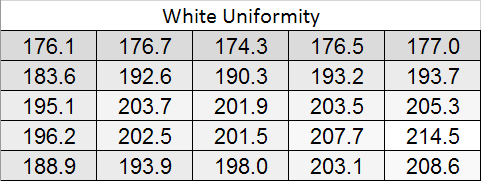

Black Uniformity is very similar. It has a drop in black level at the top, just like white does, but the rest of the screen is pretty accurate when compared to the center calibration target.
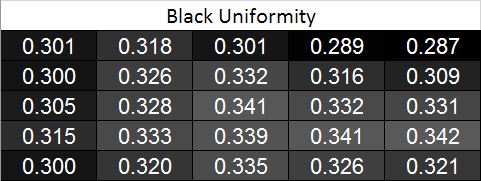
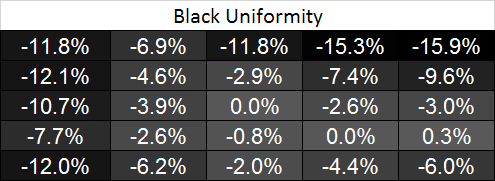
Since both White and Black have issues in the same screen areas, we wind up with a very uniform screen for our contrast ratio. It does dip down a little bit at a couple edges and corners, but most of the screen is +/- 5% when compared to center.
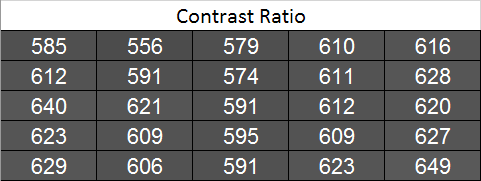

Our dE2000 errors compared to center are very good except for that top row. The lighting issue there causes a high level of error when compared to the rest of the screen, though the errors barely creep up into the visible level at the worst areas. The center of the screen is very good and would work really well for photo editing and other tasks. This makes the lack of a good sRGB mode even worse, as the good uniformity of the display would make it a nice choice for doing color critical work, but the poor gamut results make that a less likely use for it (though of course professional apps are the most likely to support the AdobeRGB color space).
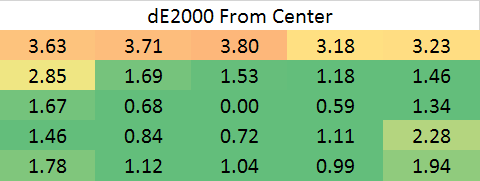
For everyone else, the display itself is very uniform except for a slightly darker area at the top. The bottom-right corner measured slightly hot, but the light bleed there was only noticeable on a pure-black screen if I was really looking for it. Otherwise the amount of light leakage is so low as to not cause a problem.










95 Comments
View All Comments
1Angelreloaded - Thursday, August 22, 2013 - link
uhm how can I break this down for you Photography and Filmography are used professionally on these monitors so MS plays a huge roll in ghosting during the film, so yes it does matter considerably, and this day in age people hybrid their workstations so they can game and do pro work on them, hence Nvidia released the Titan to fill that market, 1k for a hybrid workstation/gaming card is amazing.purerice - Wednesday, August 21, 2013 - link
To rephrase what Sancus said, there are two types of customers for >27", >1440p monitors: those who need high refresh rates and those who need high color accuracy. The intended market for the VUE 30 is the high color accuracy market.Asmodian - Tuesday, August 20, 2013 - link
The now discontinued LG W3000H had low input lag due to the lack of OSD and only one input (DVI-DL). It also has a wide gamut and mine has an uncalibrated white point of around 9000K (due to extra green instead of blue). Odd how no one seems to care about input lag on 16:10 displays anymore. Only 16:9 for gaming I guess. :(rtho782 - Tuesday, August 20, 2013 - link
My Dell WFP3007-HC has almost no input lag. The advantage of having a 30" from the days before there were any image processing chips available for 2560x1600 :PSodaAnt - Tuesday, August 20, 2013 - link
I used a dell u3011 for quite a while, which I believe has similar input lag, and I never noticed a thing in gaming. I think its just another tiny lag, keep in mind it isn't even two frames at 60 fps, and if you're running at 30 fps its not even a single frame of lag, so I doubt most people would notice it in gaming.oobble - Wednesday, August 21, 2013 - link
That is completely untrue. Most 2560x1440 27" monitors have an input lag of around 7ms.blackoctagon - Thursday, August 22, 2013 - link
Was that a reply to me? If so then what you state is incorrect, or you otherwise are referring to input lag in a different form to me. What matters is TOTAL monitor latency (a product of 'input lag' as well as pixel response time and processing time). Total latency on most IPSs is not appropriate for fast motion shooters, even though there are a select few IPSs that have low input lag, or have high refresh rates. In any case, this Nixeus is not one of these select few and is appropriate for graphics/photo design work rather than gaming.AnnonymousCoward - Thursday, August 22, 2013 - link
I think the latest Dell 30" has a game mode with sub-16ms lag. This is critical to me for ALL computer usage.Soldier1969 - Friday, August 23, 2013 - link
Uhm spoken by someone that clearly can't afford one or never used one. Only read about them I guess. Ive been gaming on a HP ZR30 for 3 years now very happy with the clarity and shooting motion but thanks nice try.ZeDestructor - Tuesday, August 20, 2013 - link
Same range as on every top-end "professional-use" wide-gamut panel. My U2410s have similar, and my 2408 is far worse at 64ms overall. All of those are eminently good for gaming. If anything, I prefer them over any fast TN because of the nicer colours. Really helps immersion :D. Sucks a bit for online p,lay though, but until eDP-based panels become a major thing, we'll still have input lag from scalers and whatnot, and in any case, you can't go below the panel response.